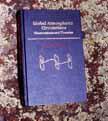
lobal
Atmospheric
Circulations

|
Global
Atmospheric
Circulations
|
All image files linked here are copyrighted to Richard Grotjahn.
Previously, errata sheets consisting of several sets
were included here as crude text and gif image files.
The files could not easily show math symbols or Greek
letters, nor was the information easily updatable (since
I go to another building to do my scanning).
I used to provide a file
using postscript format that is widely printable and viewable.
I now use pdf format for the errata.
The pdf file version of the errata is located
here. (updated
17 December 2004)
If you are not already aware of it, you can obtain a
pdf viewer for free over the net from Adobe Software,
under the name Acrobat Reader.
If you would like a printed copy from a wordprocessor, please contact me. My email is: grotjahn 'at' ucdavis 'dot' edu
Alternatively, you could also mail your request to me at:
Dept. of L.A.W.R.
One Shields Avenue
Univ. of California
Davis CA 95616-8627
U.S.A.
In order to reproduce charts and symbols from the actual homework handouts, I have simply scanned in the black and white images of each homework. What follows is a short description of each problem set file, so that the reader may skip those subjects not of interest. For obvious reasons, I have NOT included my solutions to these problems!
I have not updated these problems for several years. I encourage instructors to contact me if they are looking for more problem set ideas.
I have a short article in Dynamics of Atmospheres and Oceans vol. 27, (January 1998), pages 5-16. which includes several more homework problems (with solutions). I have reprints of this article for those who may be interested.
To assist instructors, I have provided a text file list of sample homework problems as well. This text file does not have special letters, symbols or graphics either. Thus, the items listed above are to be prefered.
In this section I shall include information and updates that reflect my thinking beyond what I wrote in the book several years ago.
One question that may arise is how can this be an area where the time mean jet decreases in strength downwind (the "jet exit") even though this is also the region where the eddy momentum flux convergence is stronger?
This discussion "under construction".
It occurs to me that one might link together a number of items presented in the book by focussing upon the interaction that occurs when a middlatitude trough extends into the tropics. Such is a regular event during winter in the middle Pacific and Atlantic oceans. I have prepared some draft schematic diagrams based upon many figures in the book. I have listed the relevant figures in the upper right corner of each image. My figures show various properties of the transient and stationary flows. I also indicate diabatic effects. Finally, all three figures are overlaid so as to see better the relationships.
The images consist of rhomboidal polygons that are intended to show approximate meridional cross sections at selected longitudes across the Pacific. The longitudes are marked -- some cross sections do not follow a meridian in order to pick up better interesting atmospheric properties. I realize that these figures are not easy to understand since one must include several processes, each with a different symbol. Nonetheless, here are some symbol definitions:
The symbols used in the figures are as follows. H and L refer to high and low pressure (where a block H or block L are stronger extrema). Precipitating clouds are indicated with a tube shape having scalloped edges. Precip is indicated with vertical lines. Single straight shafted arrows indicate wind flow. Wavy single shafted arrows indicate heat transfer between the atmosphere and the earth's surface. Arrows with double shafts indicate meridional momentum fluxes. Arrows with triple shafts indicate meridional heat fluxes. The longer an arrow, the greater the amplitude of the quantity there. Dotted lines (that extend into the dimension perpendicular to each plane are of geopotential height in the upper troposphere. T refers to trough; while block J refers to the subtropical jet stream. WBC refers to the western boundary current (it has imporant heat transport). LH refers to latent heat release.
When I have taught my course, I have slowly constructed these figures over the course of many lectures thereby providing a vehicle for review as well as illustrating the connections between properties and concepts.
One of my hobbies is stereo imagery. Plate 1 in the book can be viewed in stereo by going to a subdirectory of my stereo files by clicking here. For those who are unfamiliar with relaxed eye techniques, you may want to visit my tutorial located here.
Several locations provide user-specified Map drawing on large scales:
Return to my homepage
Return to UCD Atmospheric Science home page.
general circulation, global atmospheric circulations, book general circulation, global atmospheric circulations, book general circulation, global atmospheric circulations, book general circulation, global atmospheric circulations, book general circulation, global atmospheric circulations, book general circulation, global atmospheric circulations, book general circulation, global atmospheric circulations, book general circulation, global atmospheric circulations, book general circulation, global atmospheric circulations, book general circulation, global atmospheric circulations, book general circulation, global atmospheric circulations, book general circulation, global atmospheric circulations, book general circulation, global atmospheric circulations, book general circulation, global atmospheric circulations, book general circulation, global atmospheric circulations, book general circulation, global atmospheric circulations, book general circulation, global atmospheric circulations, book general circulation, global atmospheric circulations, book general circulation, global atmospheric circulations, book general circulation, global atmospheric circulations, book general circulation, global atmospheric circulations, book Storage: